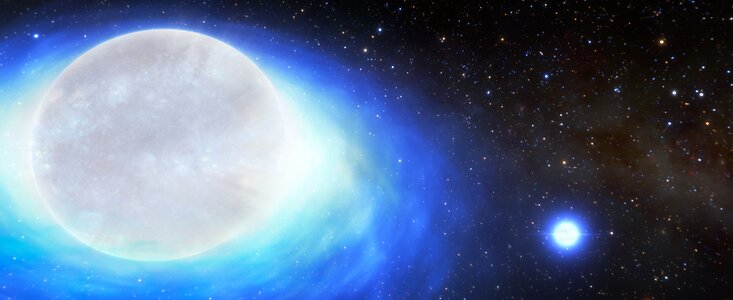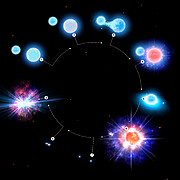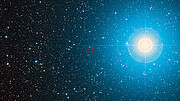First Kilonova Progenitor System Identified
Astronomers using the SMARTS 1.5-meter Telescope uncover a one-in-ten-billion binary star system
1 February 2023
Astronomers using data from the SMARTS 1.5-meter Telescope at the Cerro Tololo Inter-American Observatory (CTIO), a Program of NSF's NOIRLab, have made the first confirmed detection of a star system that will one day form a Kilonova — the ultra-powerful, gold-producing explosion created by merging neutron stars. These systems are so phenomenally rare that only about 10 such systems are thought to exist in the entire Milky Way.
Astronomers using the SMARTS 1.5-meter Telescope at Cerro Tololo Inter-American Observatory in Chile, a Program of NSF's NOIRLab, have uncovered the first example of a phenomenally rare type of binary star system, one that has all the right conditions to eventually trigger a kilonova — the ultra-powerful, gold-producing explosion created by colliding neutron stars. Such an arrangement is so vanishingly rare that only about 10 such systems are thought to exist in the entire Milky Way Galaxy. The findings are published today in the journal Nature.
This unusual system, known as CPD-29 2176, is located about 11,400 light-years from Earth. It was first identified by NASA’s Neil Gehrels Swift Observatory. Later observations with the SMARTS 1.5-meter Telescope allowed astronomers to deduce the orbital characteristics and types of stars that make up this system — a neutron star created by an ultra-stripped supernova and a closely orbiting massive star that is in the process of becoming an ultra-stripped supernova itself.
An ultra-stripped supernova is the end-of-life explosion of a massive star that has had much of its outer atmosphere stripped away by a companion star. This class of supernova lacks the explosive force of a traditional supernova, which would otherwise “kick” a nearby companion star out of the system.
“The current neutron star would have to form without ejecting its companion from the system. An ultra-stripped supernova is the best explanation for why these companion stars are in such a tight orbit,” said Noel D. Richardson at Embry-Riddle Aeronautical University and lead author of the paper. “To one day create a Kilonova, the other star would also need to explode as an ultra-stripped supernova so the two neutron stars could eventually collide and merge.”
As well as representing the discovery of an incredibly rare cosmic oddity, finding and studying Kilonova progenitor systems such as this can help astronomers unravel the mystery of how Kilonovae form, shedding light on the origin of the heaviest elements in the Universe.
“For quite some time, astronomers speculated about the exact conditions that could eventually lead to a Kilonova,” said NOIRLab astronomer and co-author André-Nicolas Chené. “These new results demonstrate that, in at least some cases, two sibling neutron stars can merge when one of them was created without a classical supernova explosion.”
Producing such an unusual system, however, is a long and unlikely process. “We know that the Milky Way contains at least 100 billion stars and likely hundreds of billions more. This remarkable binary system is essentially a one-in-ten-billion system,” said Chené. “Prior to our study, the estimate was that only one or two such systems should exist in a spiral galaxy like the Milky Way.”
Though this system has all the right stuff to eventually form a Kilonova, it will be up to future astronomers to study that event. It will take at least one million years for the massive star to end its life as a titanic supernova explosion and leave behind a second neutron star. This new stellar remnant and the pre-existing neutron star will then need to gradually draw together in a cosmic ballet, slowly losing their orbital energy as gravitational radiation.
When they eventually merge, the resulting Kilonova explosion will produce much more powerful gravitational waves and leave behind in its wake a large amount of heavy elements, including silver and gold.
“This system reveals that some neutron stars are formed with only a small supernova kick,” concluded Richardson. “As we understand the growing population of systems like CPD-29 2176 we will gain insight into how calm some stellar deaths may be and if these stars can die without traditional supernovae.”
More information
This research was presented in the paper “A high-mass X-ray binary descended from an ultra-stripped supernova” to appear in the journal Nature.
The team is composed of Noel D. Richardson (Embry-Riddle Aeronautical University), Clarissa Pavao (Embry-Riddle Aeronautical University), Jan J. Eldridge (University of Auckland), Herbert Pablo (American Association of Variable Star Observers), André-Nicolas Chené (NSF’s NOIRLab/Gemini Observatory), Peter Wysocki (Georgia State University), Douglas R. Gies (Georgia State University), Georges Younes (The George Washington University), and Jeremy Hare (NASA Goddard Space Flight Center).
NSF’s NOIRLab, the US center for ground-based optical-infrared astronomy, operates the International Gemini Observatory (a facility of NSF, NRC–Canada, ANID–Chile, MCTIC–Brazil, MINCyT–Argentina, and KASI–Republic of Korea), Kitt Peak National Observatory (KPNO), Cerro Tololo Inter-American Observatory (CTIO), the Community Science and Data Center (CSDC), and Vera C. Rubin Observatory (operated in cooperation with the Department of Energy’s SLAC National Accelerator Laboratory). It is managed by the Association of Universities for Research in Astronomy (AURA) under a cooperative agreement with NSF and is headquartered in Tucson, Arizona. The astronomical community is honored to have the opportunity to conduct astronomical research on Iolkam Du’ag (Kitt Peak) in Arizona, on Maunakea in Hawai‘i, and on Cerro Tololo and Cerro Pachón in Chile. We recognize and acknowledge the very significant cultural role and reverence that these sites have to the Tohono O'odham Nation, to the Native Hawaiian community, and to the local communities in Chile, respectively.
Links
Contacts
Noel D. Richardson
Embry-Riddle Aeronautical University
Email: noel.richardson@erau.edu
André-Nicolas Chené
NSF’s NOIRLab
Email: andre-nicolas.chene@noirlab.edu
Todd Henry
SMARTS Consortium Director
Email: thenry@astro.gsu.edu
Tyler Linder
SMARTS Consortium Deputy Director
Email: tlinder34@gmail.com
Charles Blue
Public Information Officer
NSF’s NOIRLab
Tel: +1 202 236 6324
Email: charles.blue@noirlab.edu
About the Release
| Release No.: | noirlab2303 |
| Facility: | SMARTS 1.5-meter Telescope |
| Science data: | 2023Natur.614...45R |






